Middleton W.M. (ed.) Reference Data for Engineers: Radio, Electronics, Computer and Communications
Подождите немного. Документ загружается.

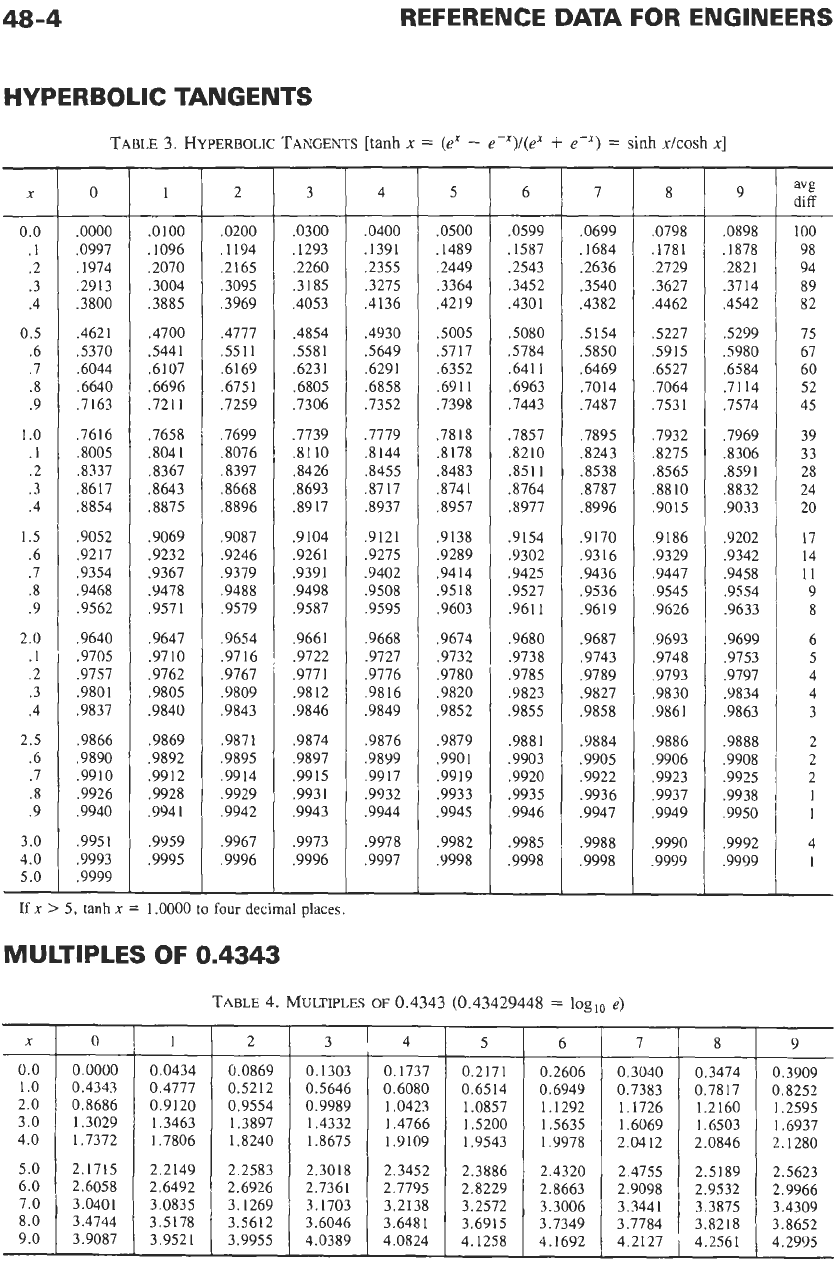
48-4
6
,0599
.1587
.2543
,3452
.4301
,5080
,5784
.6411
,6963
,7443
,7857
,8210
,8511
,8764
,8977
HYPERBOLIC TANGENTS
TABLE 3. HYPERBOLIC TANGENTS
[tanh
x
=
(e"
-
e-")/(e"
+
e-")
=
sinh
xicosh
x]
7
,0699
,1684
,2636
,3540
,4382
.5154
,5850
,6469
,7014
,7487
,7895
,8243
.8538
,8787
,8996
0.0
.1
.2
.3
.4
0.5
.6
.7
.8
.9
1
.o
.1
.2
.3
.4
1.5
.6
.7
.8
.9
2.0
.1
.2
.3
.4
2.5
.6
.7
.8
.9
3.0
4.0
5.0
,0300
,1293
,2260
,3185
,4053
.4854
,5581
,6231
,6805
,7306
.7739
,8110
,8426
,8693
,8917
,9104
.9261
,9391
,9498
,9587
,9661
,9722
.9711
,9812
,9846
,9874
.9897
,9915
,9931
,9943
,9973
,9996
.oooo
,0997
,1974
,2913
.3800
,4621
,5370
,6044
,6640
,7163
,7616
,8005
,8337
,8617
,8854
,9052
,9217
,9354
,9468
,9562
,9640
,9705
.9757
,9801
,9837
,9866
,9890
,9910
,9926
,9940
,9951
,9993
,9999
,0400
,1391
,2355
.3275
,4136
.4930
,5649
,6291
,6858
,7352
,7779
,8144
,8455
,8717
,8937
,9121
,9275
.9402
.9508
,9595
,9668
.9727
,9776
.9816
,9849
,9876
,9899
,9917
,9932
,9944
,9978
,9997
1
,0100
,1096
,2070
,3004
,3885
.4700
S441
.6107
,6696
,7211
.7658
,8041
,8367
,8643
,8875
,9069
,9232
,9367
,9478
,9571
,9647
,9710
,9762
,9805
.9840
,9869
,9892
,9912
,9928
,994 1
,9959
,9995
.9154
,9302
,9425
.9527
.9611
,9680
,9738
,9785
,9823
,9855
.9881
.9903
,9920
,9935
,9946
.9985
.9998
2
,9170
,9316
,9436
,9536
.9619
,9687
,9743
,9789
,9827
,9858
,9884
,9905
,9922
,9936
,9947
,9988
,9998
,0200
,1194
,2165
,3095
,3969
,4777
,5511
,6169
,6751
,7259
.7699
,8076
,8397
,8668
,8896
,9087
,9246
.9379
,9488
,9579
,9654
,9716
,9767
.9809
,9843
,9871
,9895
,9914
.9929
,9942
,9967
.9996
0
0.0000
0.4343
0.8686
1.3029
1.7372
2.1715
2.6058
3.0401
3.4744
3.9087
314
1 2
0.0434 0.0869
0.4177 0.5212
0.9120 0.9554
1.3463 1.3897
1.7806 1.8240
2.2149 2.2583
2.6492 2.6926
3.0835 3.1269
3.5178 3.5612
3.9521 3.9955
5
,0500
,1489
,2449
,3364
,4219
,5005
,5717
,6352
,6911
,7398
,7818
.8178
,8483
,8741
,8957
,9138
.9289
,9414
,9518
,9603
,9674
,9732
.9780
,9820
,9852
,9879
,9901
,9919
,9933
.9945
,9982
.9998
If
x
>
5,
tanh
n
=
1,0000
to
four
decimal
places.
MULTIPLES
OF
0.4343
TABLE
4.
MULTIPLES
OF
0.4343 (0.43429448
=
log,o
e)
X
0.0
1
.o
2.0
3.0
4.0
5.0
6.0
7.0
8.0
9.0
3
0.1303
0.5646
0.9989
1.4332
1.8675
2.3018
2.7361
3.1703
3.6046
4.0389
6
0.2606
0.6949
1.1292
1.5635
1.9978
2.4320
2.8663
3.3006
3.7349
4.1692
8
,0798
,1781
,2729
,3627
,4462
,5227
,5915
,6527
,7064
,7531
,7932
,8275
,8565
.8810
,9015
,9186
,9329
,9447
,9545
,9626
.9693
.9748
,9793
,9830
,9861
,9886
,9906
,9923
.9937
,9949
,9990
,9999
7
0.3040
0.7383
1.1726
1.6069
2.0412
2.4755
2.9098
3.3441
3.7784
4.2127
9
,0898
,1878
.2821
.3714
,4542
,5299
,5980
,6584
,7114
,7574
,7969
,8306
,8591
,8832
,9033
.9202
.9342
,9458
,9554
.9633
,9699
,9753
,9797
,9834
,9863
.9888
,9908
.9925
,9938
,9950
,9992
,9999
8
0.3474
0.7817
1.2160
1.6503
2.0846
2.5189
2.9532
3.3875
3.8218
4.2561
avg
diff
100
98
94
89
82
75
67
60
52
45
39
33
28
24
20
17
14
11
9
8
6
5
4
4
3
2
2
2
1
1
4
1
-
9
0.3909
0.8252
1.2595
1.6937
2.1280
2.5623
2.9966
3.4309
3.8652
4.2995
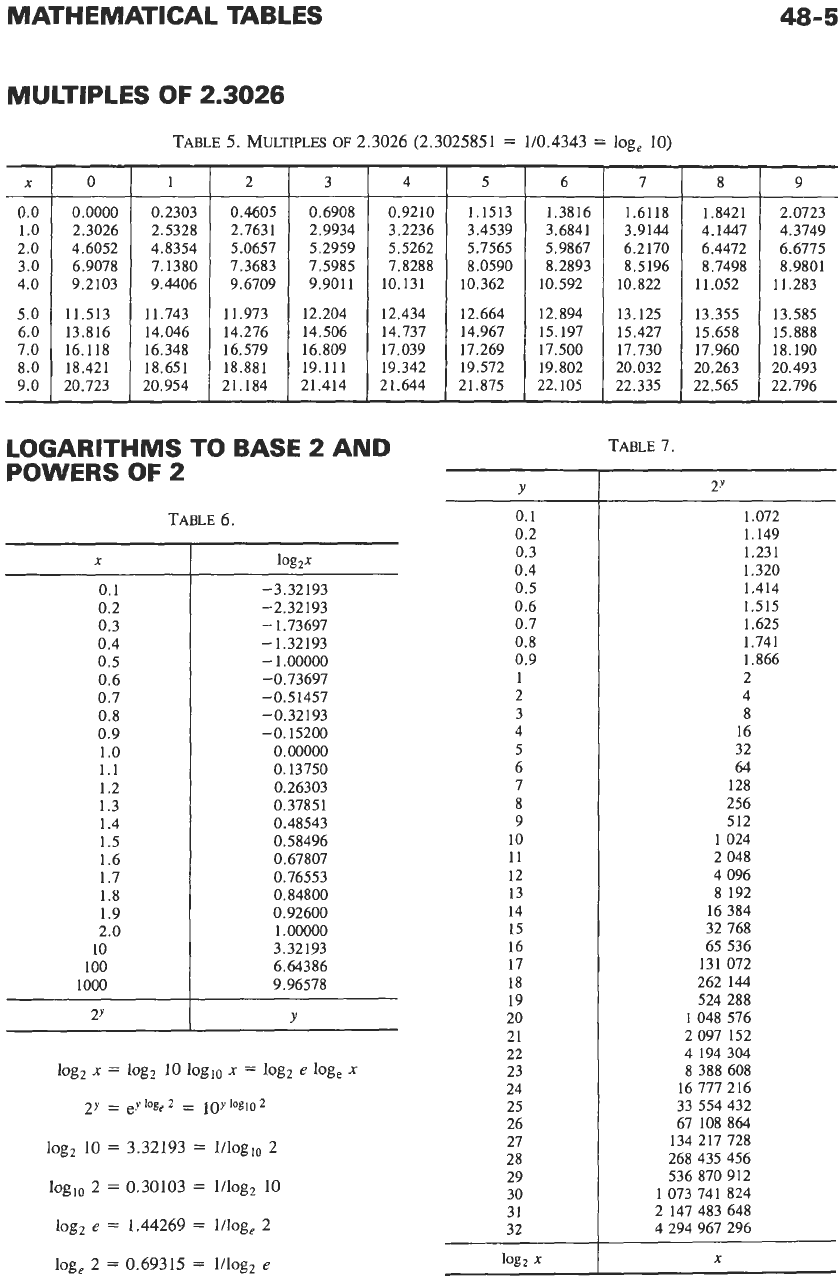
48-5
0.0
1.0
2.0
3.0
4.0
5.0
6.0
7.0
8.0
9.0
MULTIPLES
OF
2.3026
TABLE
5.
MULTIPLES
OF
2.3026 (2.3025851
=
U0.4343
=
log,
10)
0.0000
0.2303 0.4605 0.6908 0.9210 1.1513
1.3816
2.3026 2.5328 2.7631 2.9934 3.2236 3.4539 3.6841
4.6052 4.8354
5.0657 5.2959 5.5262 5.7565 5.9867
6.9078 7.1380
7.3683 7.5985
7.8288 8.0590
8.2893
9.2103
9.4406 9.6709
9.9011 10.131 10.362 10.592
11.513
11.743 11.973
12.204 12.434 12.664 12.894
13.816 14.046 14.276
14.506 14.737
14.967 15.197
16.118 16.348
16.579 16.809
17.039 17.269
17.500
18.421 18.651
18.881 19.111 19.342 19.572 19.802
20.723 20.954
21.184 21.414 21.644 21.875 22.105
1.6118
3.9144
6.2170
8.5196
10.822
13.125
15.427
17.730
20.032
22.335
1.8421 2.0723
4.1447 4.3749
6.4472 6.6775
8.7498 8.9801
11.052 11.283
13.355 13.585
15.658 15.888
17.960 18.190
20.263 20.493
22.565 22.796
LOGARITHMS TO BASE
2
AND
POWERS
OF
2
TABLE 6.
X
0.1
0.2
0.3
0.4
0.5
0.6
0.7
0.8
0.9
1
.o
1.1
1.2
1.3
1.4
1.5
1.6
1.7
1.8
1.9
2.0
10
100
1000
2y
-3.32193
-2.32193
-
1.73697
-1.32193
-
1.00000
-0.73697
-0.51457
-
0.32 193
-0.15200
0.00000
0.13750
0.26303
0.37851
0.48543
0.58496
0.67807
0.76553
0.84800
0.92600
1
.ooooo
3.321 93
6,64386
9.96578
Y
logz
x
=
log2
10
loglo
x
=
log2
e
log,
x
2Y
=
eY
log,
2
=
10Y
loglo
2
log2
10
=
3.32193
=
I/loglO
2
lOg,o 2
=
0,30103
=
l/lOgz
10
log2
e
=
1.44269
=
Mog, 2
log,
2
=
0.69315
=
l/logz
e
Y
0.1
0.2
0.3
0.4
0.5
0.6
0.7
0.8
0.9
1
2
3
4
5
6
7
8
9
10
11
12
13
14
15
16
17
18
19
20
21
22
23
24
25
26
27
28
29
30
31
32
TABLE
7.
2y
1.072
1.149
1.231
1.320
1.414
1.515
1.625
1.741
1.866
2
4
8
16
32
64
128
256
512
1
024
2 048
4 096
8 192
16 384
32 768
65 536
131 072
262 144
524 288
P
048 576
2 097 152
4
194 304
8
388 608
16 777 216
33 554 432
67 108 864
134 217 728
268 435 456
536 870 912
1
073 741 824
2 147 483 648
4
294 967 296
X
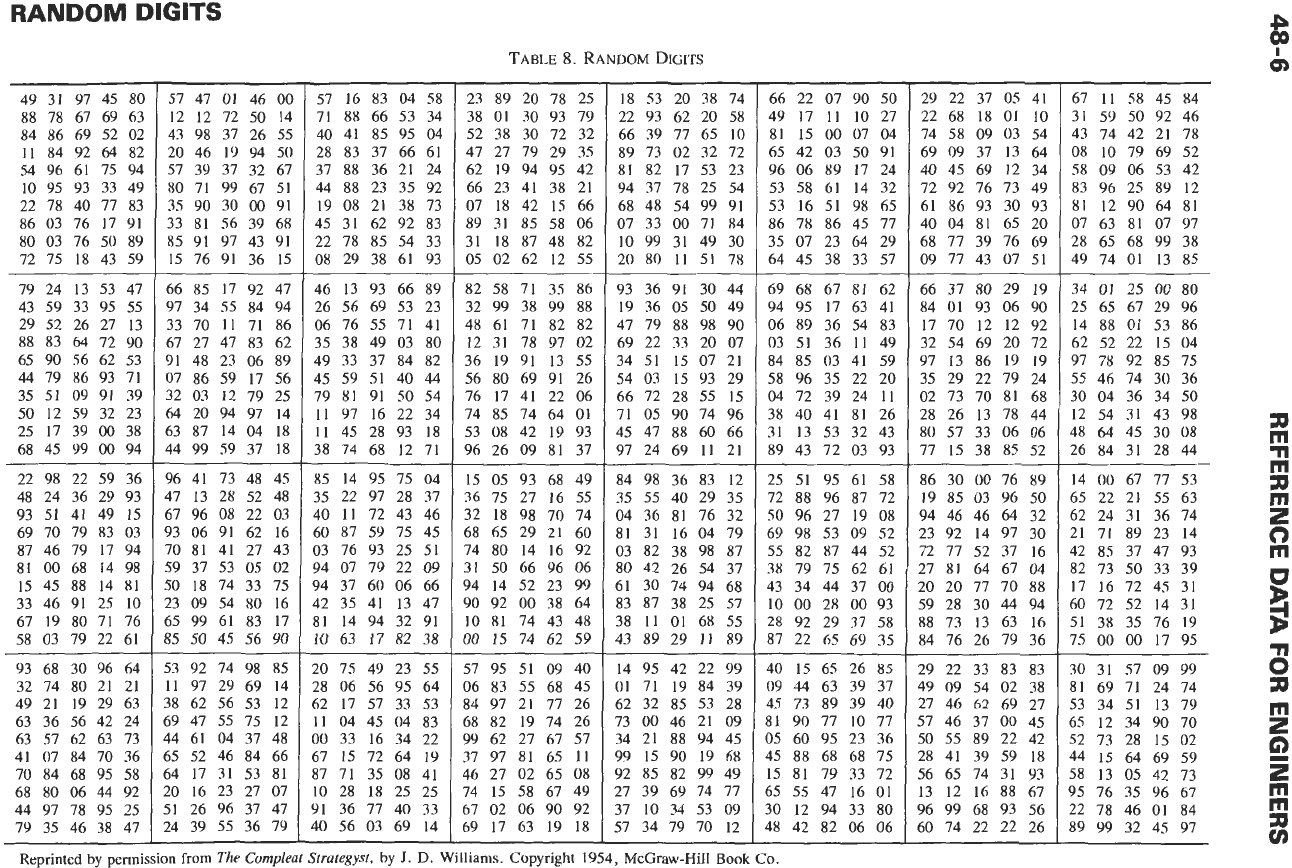
TABLE
8.
RANDOM
DIGITS
49 31 97 45 80
88 78 67 69 63
84 86 69 52 02
11
84 92 64 82
54 96 61 75 94
10 95 93 33 49
22
78 40 77 83
86 03 76 17 91
80 03 76 50 89
72 75 18 43
59
79 24
13
53 47
43 59 33 95 55
29 52 26 27 13
88 83 64 72 90
65 90 56 62 53
44 79 86 93 71
35 51 09 91 39
50 12 59 32 23
25 17 39
00
38
68 45 99
00
94
22 98 22 59 36
48 24 36 29 93
93 51 41 49 15
69 70 79 83 03
87 46 79 17 94
81
00
68 14 98
15 45 88 14 81
33 46 91 25
10
67 19 80 71 76
58 03 79 22 61
93 68 30 96 64
32 74 80
21
21
49
21
19
29 63
63 36 56 42 24
63 57 62 63 73
41 07 84 70 36
70 84 68 95 58
68 80 06 44 92
44 97 78 95 25
79 35 46 38 47
~~~ ~
57 47
01
46
00
12 12 72 50 14
43 98 37 26 55
20 46 19 94 50
57 39 37 32 67
80 71 99 67 51
35 90 30
00
91
33 81 56 39 68
85 91 97 43 91
15 76 91 36 15
66 85
17 92 47
97 34
55 84 94
33 70 11 71 86
67
27 47 83 62
91 48 23 06 89
07 86 59 17 56
32 03
12 79 25
64 20
94 97 14
63 87
14 04 18
44
99 59 37 18
96 41 73 48 45
47 13 28 52 48
57 96 08 22 03
33 06 91 62 16
70
81 41 27 43
59 37 53
05
02
50
18 74 33 75
23 09 54 80 16
55 99 61 83 17
35
50
45 56 90
53
92 74 98 85
I1
97
29 69 14
38
62
56 53 12
59 47 55 75 12
14
61 04 37 48
55
52 46
84 66
54
17 31
53 81
?O
16 23 27 07
51
26 96
31
47
!4
39 55 36 79
-
57 16 83 04 58
71 88 66 53 34
40 41 85 95 04
28 83 37 66 61
37 88 36
21
24
44 88 23 35 92
19 08 21 38 73
45 31 62 92 83
22 78 85 54 33
OX
29 38 61 93
46 13 93 66 89
26 56
69 53 23
06 76
55 71 41
35 38 49 03 80
49 33
37 84 82
45
59 51 40 44
79 81 91 50 54
11 97 16 22 34
11
45
28 93 18
38 74
68 12 71
~ ~
85 14 95 75 04
35
22
97
28 37
40
11
72 43 46
60 87 59 75 45
03 76 93 25 51
94 07 79 22 09
94 37 60 06 66
42 35 41 13 47
81 14 94 32 91
10
63
17
82 38
20 75 49 23 55
28 06 56 95 64
62
17 57 33
53
11
04
45 04 83
00
33
16 34 22
67 15
72 64 19
87 71
35 08 41
10 28 18 25
25
91
36
77 40 33
40 56 03 69
14
23 89 20 78 25
38
01
30 93 79
52 38 30 72 32
47 27 79 29 35
62 19 94 95 42
66 23 41 38 21
07 18 42 15 66
89 31 85 58 06
31 18 87 48 82
05
02 62 12 55
82 58
71
35 86
32 99 38 99 88
48 61
71
82 82
12
31 78 97 02
36 19 91 13 55
56 80
69
91 26
76 17 41 22 06
74 85
74
64 01
53 08
42
19 93
96 26 09 81 37
15 05 93 68 49
36 75 27 16 55
32 18 98 70 74
68 65 29 21 60
74 80 14 16 92
31 50 66 96 06
94 14 52 23 99
90 92
00
38 64
10
81 74 43 48
00
15
74 62 59
57 95
51
09 40
06 83 55 68 45
84 97 21
77 26
68 82
19 74 26
99 62 27
67 57
37 97 81
65
11
46 27 02
65 08
74
15
58
67 49
67 02 06
90 92
69 17 63
19 18
~~
18 53 20 38 74
22 93 62 20
58
66 39 77 65
10
89 73
02 32 72
81 82 17 53
23
94 37 78 25 54
68 48 54 99 91
07 33
00
71
84
10
99
31 49 30
20 80
11
51
78
93 36
91
30 44
19
36
05 50 49
47
79
88
98 90
69
22
33
20 07
34
51
15
07
21
54 03
15 93 29
66
72
28
55 15
71 05
90
74 96
45
47
88 60 66
97
24
69
11
21
84 98 36 83 12
35 55 40 29 35
04 36 81 76 32
81 31 16 04 79
03 82 38 98 87
80 42 26 54 37
61 30 74 94 68
83 87 38 25 57
38
11
01 68 55
43 89 29
11
89
14 95 42
22 99
01
71
19 84 39
62 32
85
53 28
73
00
46
21
09
34 21 88
94 45
99 15 90 19 68
92 85
82
99 49
27
39
69
74 71
37
10
34
53
09
57 34
79
70 12
66 22
07
90
50
49 17 11 10 27
81 15
00
07 04
65 42 03 50 91
96
06
89 17 24
53 58 61 14 32
53 16 51 98 65
86 78 86 45 77
35 07 23 64 29
64 45 38 33 57
69 68 67 81 62
94 95
17 63 41
06 89 36
54 83
03 51 36
11 49
84 85 03 41 59
58 96 35 22 20
04 72
39 24 11
38 40 41
81 26
31 13 53 32 43
89 43 72 03 93
25 51 95 61 58
72 88 96 87 72
50 96 27 19 08
69 98 53
09 52
55 82 87
44
52
38 79
75 62 61
43 34 44
37
00
IO
00
28
00
93
28
92
29
37 58
87 22
65 69
35
40
15
65 26 85
09 44 63 39 37
45 73 89 39 40
81 90 77 10 77
05 60 95 23 36
45 88 68 68 75
15 81 79 33 72
65 55 47 16
01
30 12 94 33 80
48 42 82 06 06
29 22
37
05
41
22 68
18
01
10
74 58
09
03 54
69 09
37
13 64
40 45
69
12 34
72 92
76
73 49
61 86
93 30 93
40 04 81 65 20
68 17
39
76 69
09 77
43
07 51
66
37
80
29
19
84
01
93 06 90
17 70 12 12 92
32 54 69 20 72
97 I3
86
I9
19
35 29 22 79 24
02
73 70 81 68
28 26 13 78 44
80 57 33 06 06
77 15
38 85 52
86 30
00
76 89
19 85
03 96 50
94 46
46 64 32
23 92
14 97 30
72 77
52 37 16
27
81
64 67 04
20 20 77 70 88
59 28
30 44 94
88 73
13 63 16
84
76
26 79 36
29 22
33
83 83
49 09 54 02 38
27 46 62 69 27
57
46
37
00
45
50 55 89 22 42
28
41
39 59
18
56 65
74
31 93
13 12
16 88 67
96 99
68 93 56
60 74
22
22 26
67
11
58
45 84
31
59
50
92 46
43
74
42 21
78
08 10
79 69 52
58
09
06
53 42
83
96 25 89 12
81
12
90 64
81
07
63 81 07
97
28 65 68 99 38
49 74
01 13
85
34
01
25
00
80
25
65
67 29 96
14
88
01 53 86
62
52 22 15 04
97
78 92 85 75
55 46
74 30 36
30
04 36 34
50
12 54
31 43 98
48
64
45 30 08
26 84 31 28 44
14
00
67 77 53
65
22
21
55 63
62 24
31
36 74
21 71
89
23 14
42 85 37 47 93
82 73
50 33 39
17
16
72 45 31
60 72 52 14 31
51 38 35 76 19
75
00
00
17 95
30 31 57
09 99
81 69 71
24 74
53
34 51 13 79
65
12 34 90
70
52 73 28
15 02
44
15 64 69 59
58
13 05 42 73
95
76 35 96 67
22 78 46
01 84
89
99 32 45
97
Reprinted
by
permission
from
The
Compleat
Srrategyst,
by
I.
D.
Williams.
Copyright
1954,
McCraw-Hill
Book
Co.
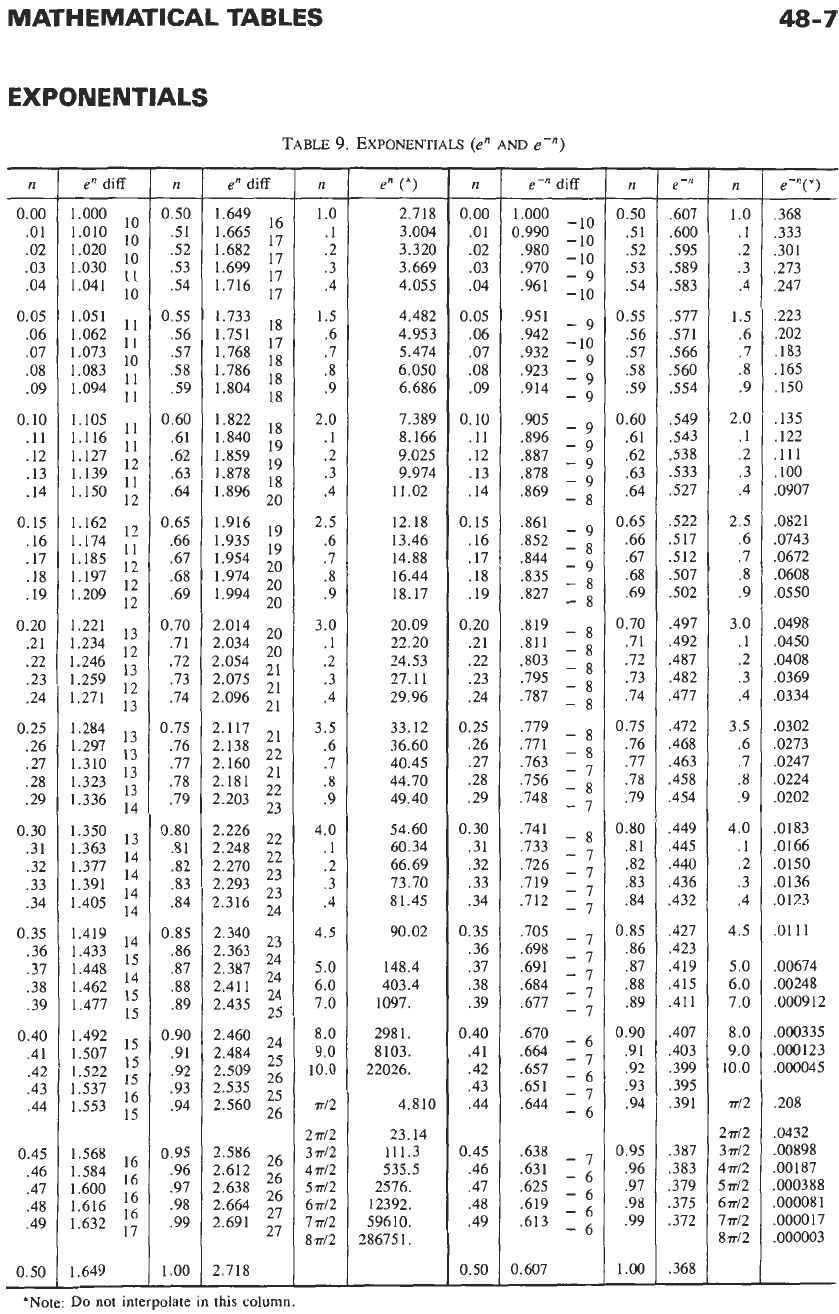
MATHEMATICAL TABLES
EXPONENTIALS
-
n
0.00
.01
.02
.03
.04
0.05
.06
.07
.08
.09
0.10
.ll
.12
.13
.14
0.15
.16
.17
.I8
.19
0.20
.21
.22
.23
.24
0.25
.26
.27
.28
.29
0.30
.31
.32
.33
.34
0.35
.36
.37
.38
.39
0.40
.41
.42
.43
.44
0.45
.46
.47
.48
.49
0.50
-
~~ ~
e"
diff
1.000
1o
1.010
1.020
1.030
11
1.041
1.051
11
1.062
11
1.073
1.083
11
1.094
11
1.105
11
1.116
11
1.127
12
1.139
11
1.150
12
1.162
12
1.174
11
1.185
12
1.197
12
1.209
12
1.234
12
1.246
13
1.259
12
1.271
13
1.284
13
1.297
13
1.310
13
1.323
13
1.336
14
1.350
13
1.363
14
1.377 14
1.391
14
1.405
14
1.419
14
1.433
15
1.448
14
1.462
15
1.477
15
1.492
15
1.507
15
1.522
15
1.537
16
1.553
15
1.568
16
1.584
16
1.600
16
1.616
16
1.632
17
1.649
1.221
13
-
n
0.50
.5
1
.52
.53
.54
0.55
.56
.57
.58
.59
0.60
.61
.62
.63
.64
0.65
.66
.67
.68
.69
0.70
.71
.72
.73
.74
0.75
.76
.77
.78
.79
0.80
.81
.82
.83
.84
0.85
.86
.87
.88
.89
0.90
.91
.92
.93
.94
3.95
.96
.97
.98
.99
I
.oo
-
TABLE
9.
EXPONENTIALS
(e"
AND
e-")
e"
diff
1.649
16
1.665 17
1.682
17
1.699 17
1.716
17
1.733
18
1.751 17
1.768
18
1.786
18
1.804 18
1.822
18
1.840
19
1.859
19
1.878
18
1.896
2o
1.916
19
1.935
19
1.954
20
1.974
2o
1.994
2o
2.014
2o
2.034
2o
2.054
21
2.075
21
2.096
21
2.117
21
2.138
22
2.160
21
2.181
22
2.203
23
2.226
22
2.248
22
2.270
23
2.293
23
2.316
24
2.340
23
2.363
24
2.387
24
2.411
24
2.435
25
2.460
24
2.484
25
2.509
26
2.535
25
2.560
26
2.586
26
2.612
26
2.638
26
2.664
27
2.691
27
2.718
-
n
1
.o
.1
.2
.3
.4
1.5
.6
.7
.8
.9
2.0
.1
.2
.3
.4
2.5
.6
.7
.8
.9
3.0
.I
.2
.3
.4
3.5
.6
.7
.8
.9
4.0
.1
.2
.3
.4
4.5
5.0
6.0
7.0
8.0
9.0
10.0
TI2
2Tl2
3~12
4~12
MI2
6~12
7 ~12
8
d2
-
e"
(*)
2.718
3.004
3.320
3.669
4.055
4.482
4.953
5.474
6.050
6.686
7.389
8.166
9.025
9.974
11.02
12.18
13.46
14.88
16.44
18.17
20.09
22.20
24.53
27.11
29.96
33.12
36.60
40.45
44.70
49.40
54.60
60.34
66.69
73.70
8
1.45
90.02
148.4
403.4
1097.
298
1.
8103.
22026.
4.810
23.14
111.3
535.5
2576.
12392.
59610.
286751,
-
n
0.00
.01
.02
.03
.04
0.05
.06
.07
.08
.09
0.10
.ll
.12
.13
.14
0.15
.16
I17
.18
.19
0.20
.21
.22
.23
.24
0.25
.26
.27
.28
.29
0.30
.31
.32
.33
.34
0.35
.36
.37
.38
.39
0.40
.41
.42
.43
.44
-
0.45
.46
.47
.48
.49
0.50
-
e-"
diff
1.000
0.990
,980 -10
,961 -10
,970
-
,951
-
,942
.932
1';
.923
-
,914
-
,905
-
,896
,887
1
,878
-
,869
-
,861
-
,852
-
.844
-
.835
,827
I
.819
-
,811
,803
1
.787
-
,795
-
,779
-
,771
-
,763
-
,756
-
.748
-
,741
-
,733
-
,719
-
,712
-
,726
-
.705
-
,698
-
,691
-
,684
-
,677
-
.670
-
.664
-
,657
-
,651
-
,644
-
.638
-
.631
-
,625
,619
-
,613
I
D.607
-
n
0.50
.51
.52
.53
.54
0.55
.56
.57
.58
.59
0.60
.61
.62
.63
.64
0.65
.66
.67
.68
.69
0.70
.71
.72
.73
.74
0.75
.76
.77
.78
.79
0.80
.81
.82
.83
.84
0.85
.86
.87
.88
.89
0.90
.91
.92
.93
.94
-
0.95
.96
.97
.98
.99
1
.oo
-
-
e
-n
,607
,600
,595
,589
,583
,577
.571
,566
,560
,554
,549
.543
,538
,533
,527
,522
,517
,512
,507
,502
,497
,492
,487
,482
,477
,472
,468
,463
,458
.454
,449
,445
,440
,436
,432
,427
,423
,419
,415
.411
,407
,403
,399
,395
,391
__
,387
,383
379
,375
,372
,368
-
-
n
1.0
.I
.2
.3
.4
1.5
.6
.7
.8
.9
2.0
.I
.2
.3
.4
2.5
.6
.7
.8
.9
3.0
.1
.2
.3
.4
3.5
.6
.7
.8
.9
4.0
,I
.2
.3
.4
4.5
5.0
6.0
7.0
8.0
9.0
10.0
TI2
2d2
3~12
4~12
Sd2
6~12
7
d2
8~12
-
-
4%-7
e-"(*)
.368
,333
.301
,273
,247
,223
,202
.183
,165
,150
,135
.122
,111
,100
,0907
,0821
.0743
,0672
,0608
,0550
.0498
,0450
,0408
,0369
,0334
.0302
,0273
,0247
.0224
,0202
,0183
,0166
,0150
,0136
,0123
,0111
,00674
,00248
.000912
,000335
,000123
.000045
,208
,0432
,00898
,00187
,000388
.00008
1
.OOOO
17
.000003
*Note:
Do
not
interpolate in
this
column.
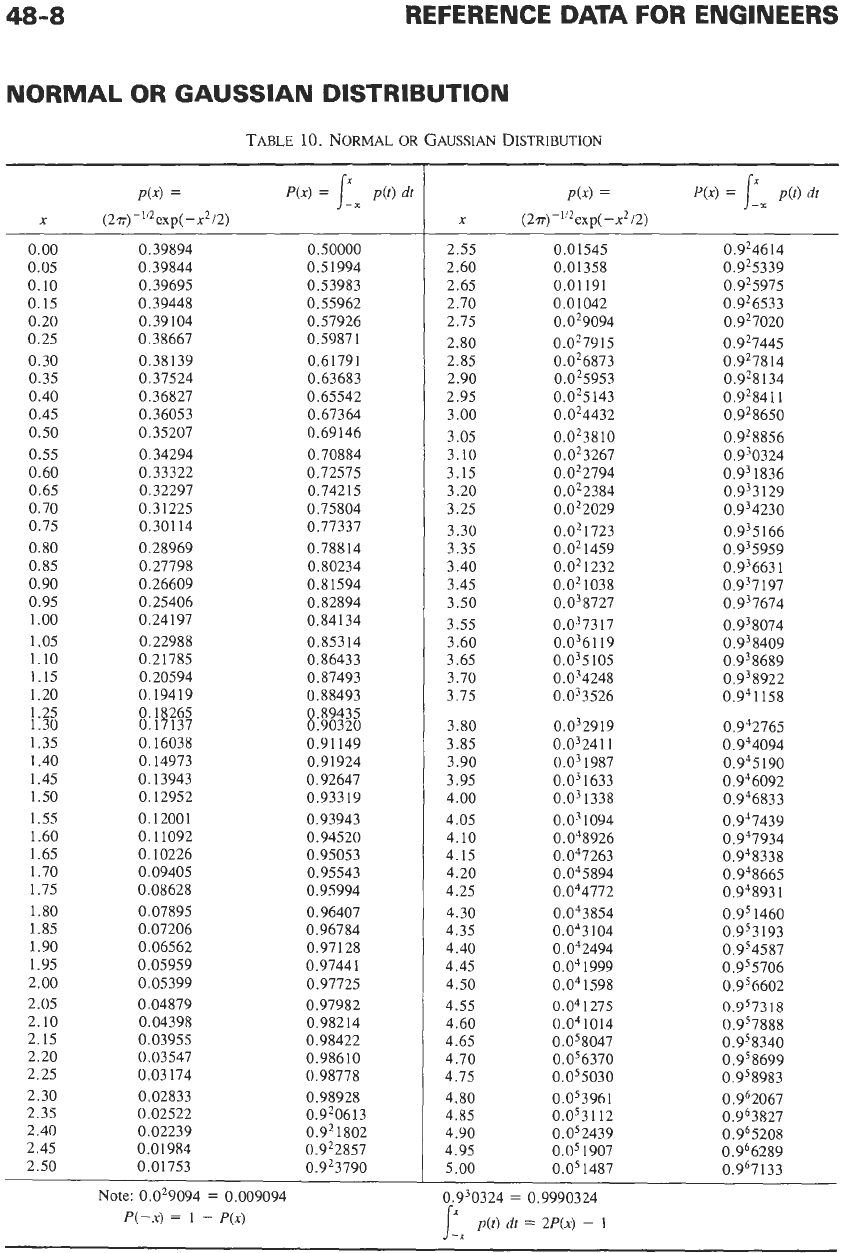
48-8
NORMAL OR GAUSSIAN DISTRIBUTION
TABLE
10.
NORMAL
OR
GAUSSIAN
DISTRIBUTION
0.00
0.05
0.10
0.15
0.20
0.25
0.30
0.35
0.40
0.45
0.50
0.55
0.60
0.65
0.70
0.75
0.80
0.85
0.90
0.95
1
.oo
1.05
1.10
1.15
1.20
1.25
1.30
1.35
1.40
1.45
1.50
1.55
1.60
1.65
1.70
1.75
1.80
1.85
1.90
1.95
2.00
2.05
2.10
2.15
2.20
2.25
2.30
2.35
2.40
2.45
2.50
0.39894
0.39844
0.39695
0.39448
0.39104
0.38667
0.38 139
0.37524
0.36827
0.36053
0.35207
0.34294
0.33322
0.32297
0.31225
0.301 14
0.28969
0.27798
0.26609
0.25406
0.24197
0.22988
0.21785
0.20594
0.19419
0.18265
0.17137
0.16038
0.14973
0.13943
0.12952
0.12001
0.11092
0.10226
0.09405
0.08628
0.07895
0.07206
0.06562
0.05959
0.05399
0.04879
0.04398
0.03955
0.03547
0.03174
0.02833
0.02522
0.02239
0.01984
0.01753
0,50000
0.5 1994
0.53983
0.55962
0.57926
0.59871
0.61791
0.63683
0.65542
0.67364
0.69 146
0.70884
0.72575
0.742
I5
0.75804
0.77337
0.78814
0.80234
0.81594
0.82894
0.84134
0.85314
0.86433
0.87493
0.88493
0.89435
0.90320
0.91 149
0.9 1924
0.92647
0.93319
0.93943
0.94520
0.95053
0.95543
0.95994
0.96407
0.96784
0.97 128
0.97441
0.97725
0.97982
0.98214
0.98422
0.98610
0.98778
0.98928
0.9’0613
0.921802
0.9’2857
0.9’3790
2.55
2.60
2.65
2.70
2.75
2.80
2.85
2.90
2.95
3.00
3.05
3.10
3.15
3.20
3.25
3.30
3.35
3.40
3.45
3.50
3.55
3.60
3.65
3.70
3.75
3.80
3.85
3.90
3.95
4.00
4.05
4.10
4.15
4.20
4.25
4.30
4.35
4.40
4.45
4.50
4.55
4.60
4.65
4.70
4.75
4.80
4.85
4.90
4.95
5.00
0.01545
0.01358
0.01 191
0.0
1042
0.029094
0.0’7915
0.026873
0.0‘5953
0.0‘
5
143
0
.024432
0.023810
0.023267
0.022794
0.022384
0
.022029
0.0’1723
0.02
1459
0.021232
0.021038
0.038727
0.037317
0.0361 19
0.035105
0.034248
0.
O3
3526
0.0329 19
0.032411
0.031987
0.0’1633
0.031338
0.03
1094
0.048926
0.047263
0.045894
0.044772
0.043854
0.043104
0
.042494
0.041999
0.041598
0.04
1275
0.041014
0
.0’8047
0.056370
0.055030
0.053961
0.0531 12
0.
O5
2439
0.05
1907
0.051487
0.9’4614
0.9’5339
0.9’5975
0.926533
0.927020
0.9‘7445
0.9’7814
0.9’8134
0.9’8411
0.9’8650
0.928856
0.930324
0.931836
0.933129
0.934230
0.935166
0.935959
0.936631
0.937197
0.937674
0.938074
0.93 8409
0.938689
0.938922
0.941158
0.942765
0.944094
0.945190
0.946092
0.946833
0.947439
0.947934
0.948338
0.948665
0.948931
0.9j 1460
0.953193
0.9j4587
0.955706
0.9’6602
0.957318
0.9’7888
0.
95 8340
0.958699
0.9j8983
0.
962067
0.963827
0.
96 5208
0.966289
0.967133
Note: 0.0’9094
=
0.009094
P(-x)
=
1
-
P(x)
0.9’0324
=
0.9990324
1;
p(t)
dt
=
2P(x)
-
1
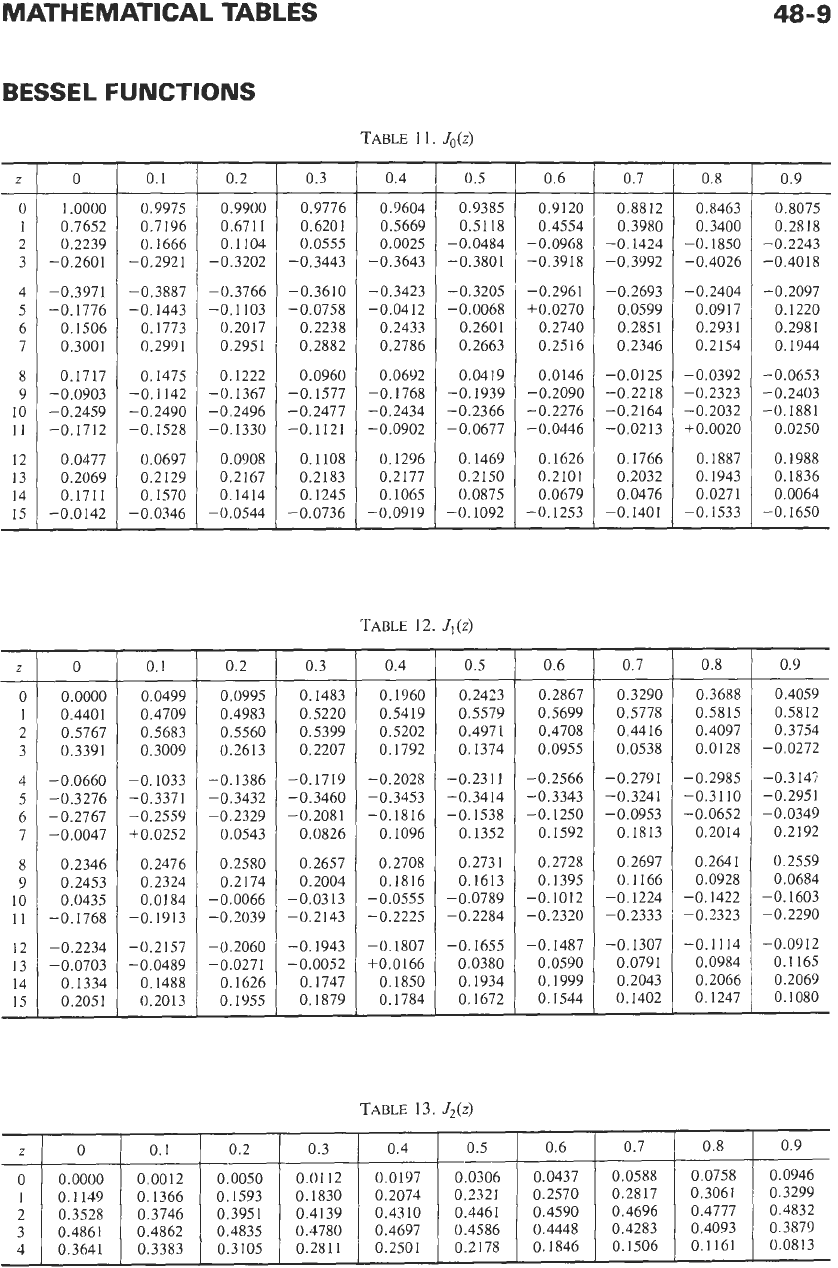
BESSEL
FUNCTIONS
2
0
1
2
3
4
5
6
7
8
9
10
11
12
13
14
15
48-9
0
1.0000
0.7652
0.2239
-0.2601
-0.3971
-0.1776
0.1506
0.3001
0.1717
-0.0903
-0.2459
-0.1712
0.0477
0.2069
0.1711
-0.0142
TABLE
1
1.
J,(z)
2
0
1
2
3
4
5
6
7
8
9
10
11
12
13
14
15
0
0.1
0.0000
0.0499
0.4401
0.4709
0.5767
0.5683
0.3391 0.3009
-0.0660
-0.1033
-0.3276
-0.3371
-0.2767 -0.2559
-0.0047 1-0.0252
0.2346 0.2476
0.2453 0.2324
0.0435 0.0184
-0.1768 -0.1913
-0.2234 -0.2157
-0.0703 -0.0489
0.1334 0.1488
0.2051 0.2013
0.1
0.9975
0.7196
0.1666
-0.292 1
-0.3887
-0.1443
0.1773
0.2991
0.1475
-0.1142
-
0.2490
-0.1528
0.0697
0.2129
0.1570
-0.0346
0.3
0.1483
0.5220
0.5399
0.2207
-0.1719
-0.3460
-0.2081
0.0826
0.2657
0.2004
-0.0313
-0.2143
-0.1943
-0.0052
0.1747
0.1879
0.4
0.1960
0.5419
0.5202
0.1792
-0.2028
-0.3453
-0.1816
0.1096
0.2708
0.1816
-0.0555
-0.2225
-0.1807
+0.0166
0.1850
0.1784
0.2
0.9900
0.6711
0.1104
-0.3202
-0.3766
-0.1 IO3
0.2017
0.2951
0.1222
-0.1367
-0.2496
-0.1330
0.0908
0.2167
0.1414
-
0.0544
0.2867
0.5699
0.4708
0.0955
-0.2566
-0.3343
-0,1250
0.1592
0.2728
0.1395
-0.1012
-0.2320
-0.1487
0.0590
0.1999
0.1544
0.2
0.0995
0.4983
0.5560
0.2613
-0.1386
-0.3432
-0.2329
0.0543
0.2580
0.2174
-0.0066
-0.2039
-
0.2060
-
0.027 1
0.1626
0.1955
0.3290
0.5778
0.4416
0.0538
-0.2791
-0.3241
-0.0953
0.1813
0.2697
0.1166
-0.1224
-0.2333
-0.1307
0.0791
0.2043
0.1402
0.3
0.9776
0.6201
0.0555
-0.3443
-0.3610
-0.0758
0.2238
0.2882
0.0960
-0.1577
-
0.2477
-0.1121
0.1108
0.2183
0.1245
-0.0736
2
0
0.1 0.2 0.3 0.4 0.5 0.6 0.7 0.8
0
0,0000
0.0012
0.0050
0,0112
0.0197
0.0306
0.0437
0.0588 0.0758
1
0.1149
0,1366
0,1593
0.1830
0.2074
0.2321
0.2570
0.2817 0.3061
2 0.3528 0.3746
0.3951
0.4139
0.4310
0.4461
0.4590
0.4696 0.4777
3 0.4861 0.4862
0.4835
0.4780
0.4697
0.4586
0.4448
0.4283 0.4093
4 0.3641
0.3383
0.3105
0.2811
0.2501
0.2178
0.1846
0.1506 0.1161
0.4
0.9604
0.5669
0.0025
-0.3643
-0.3423
-
0.04 12
0.2433
0.2786
0.0692
-0.1768
-
0.2434
-
0.0902
0.1296
0.2177
0.1065
-0.0919
0.9
0.0946
0.3299
0.4832
0.3879
0.0813
0.5
0.9385
0.5118
-0.0484
-0.3801
-0.3205
-0.0068
0.2601
0.2663
0.0419
-0.1939
-0.2366
-0.0677
0.1469
0.2150
0.0875
-0.1092
TABLE
12.
J1(z)
0.5
0.2423
0.5579
0.4971
0.1374
-0.231
1
-0.3414
-0.1538
0.1352
0.2731
0.1613
-0.0789
-0.2284
-0.1655
0.0380
0.1934
0.1672
0.6
0.9120
0.4554
-0.0968
-0.3918
-0.2961
+0.0270
0.2740
0.2516
0.0146
-0.2090
-0.2276
-0.0446
0.1626
0.2101
0.0679
-0.1253
0.7
0.8812
0.3980
-0.1424
-0.3992
-0.2693
0.0599
0.2851
0.2346
-0.01 25
-0.2218
-0.2164
-0.02 13
0.1766
0.2032
0.0476
-0.1401
~-
0.6
7
T.7
0.8
0.8463
0.3400
-0.1850
-0.4026
-0.2404
0.0917
0.2931
0.2154
-0.0392
-0.2323
-0.2032
+0.0020
0.1887
0.1943
0.0271
-0.1533
0.8
0.3688
0.5815
0.4097
0.0128
-0.2985
-0.3110
-0.0652
0.2014
0.2641
0.0928
-0.1422
-0.2323
-0.1 114
0.0984
0.2066
0.1247
0.9
0.8075
0.2818
-0.2243
-0.4018
-0.2097
0.1220
0.2981
0.1944
-0.0653
-
0.2403
-0.1881
0.0250
0.1988
0.1836
0.0064
-0.1650
0.9
0.4059
0.5812
0.3754
-0.0272
-0.3147
-0.2951
-
0.0349
0.2192
0.2559
0.0684
-0.1603
-0.2290
-0.09 12
0.1
165
0.2069
0.1080
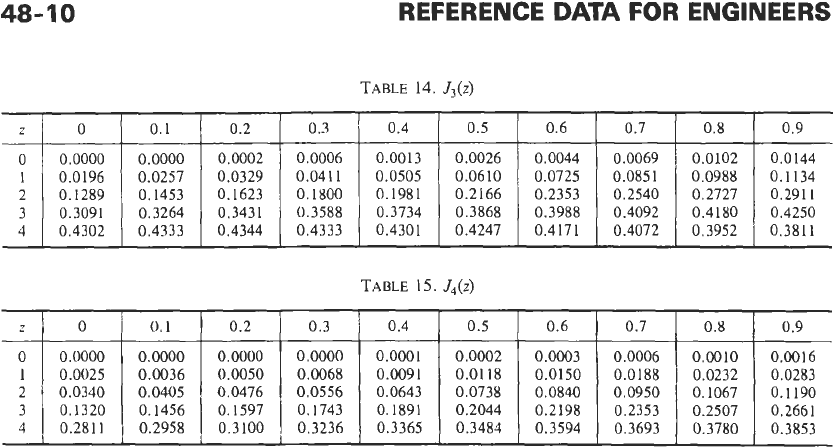
48-10
0
1
2
3
4
TABLE
14.
J3(z)
0.0000
0,0000
0.0002
0.0006 0.0013 0.0026
0.0044 0.0069
0.0196 0.0257
0.0329 0.0411
0.0505
0.0610 0.0725
0.0851
0.1289 0.1453 0.1623
0.1800 0.1981 0.2166
0.2353 0.2540
0.3091
0.3264 0.3431
0.3588 0.3734 0.3868
0.3988 0.4092
0.4302 0.4333
0.4344 0.4333
0.4301
0.4247 0.4171
0.4072
zl
0
10.1
10.2
10.3
10.4 10.5 10.6 10.7
10.8
10.9
0
1
2
3
4
0.0000
0.0000
0.0000
0.0000
0.0001
0.0002 0.0003
0.0006
0.0025 0.0036 0.0050 0.0068 0.0091
0.0118 0.0150
0.0188
0.0340 0.0405 0.0476 0.0556 0.0643
0.0738
0.0840 0.0950
0.1320 0.1456 0.1597
0.1743 0.1891
0.2044
0.2198 0.2353
0.2811
0.2958
0.3100 0.3236
0.3365
0.3484 0.3594
0.3693
TABLE
15.
J4(z)
0.0010
0.0232
0.1067
0.2507
0.3780
zj
0
1
0.1
1
0.2 0.3
1
0.4
I
0.5
I
0.6
1
0.7
I
-0.8T07
0.0016
0.0283
0.1190
0.2661
0.3853
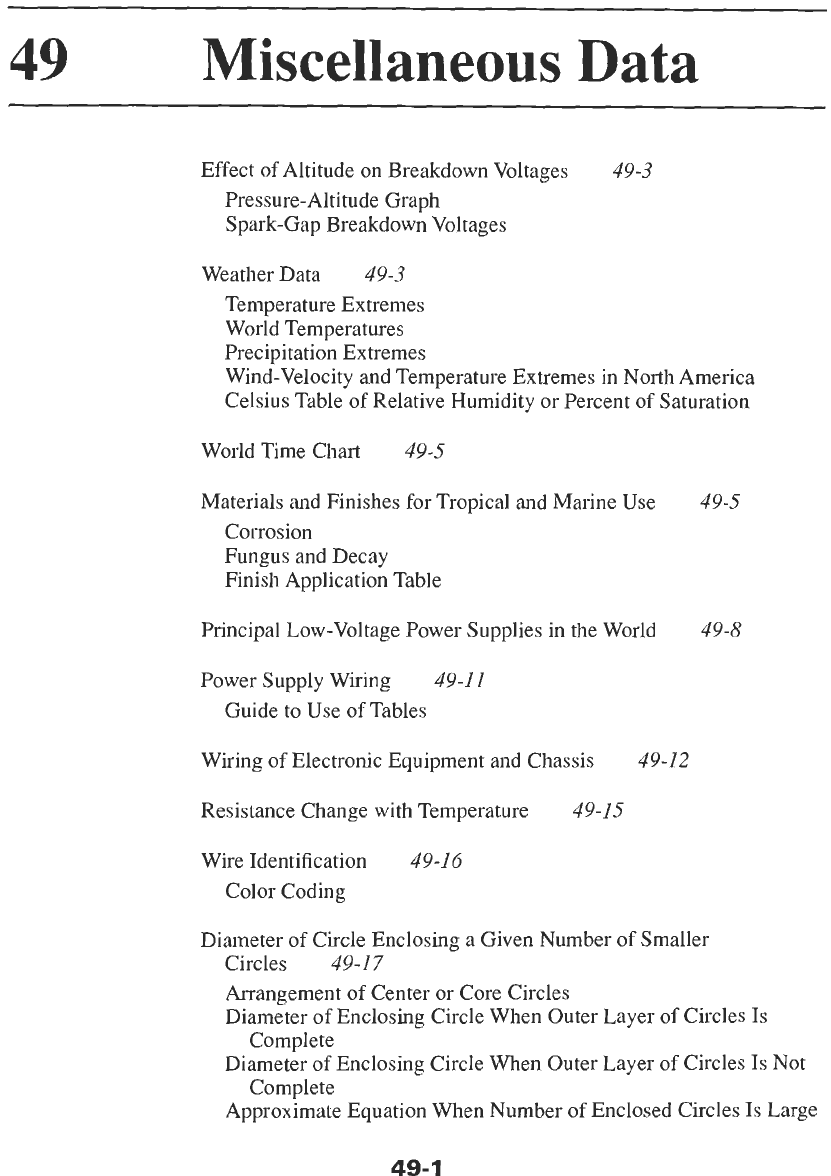
49
Miscellaneous Data
Effect
of
Altitude on Breakdown Voltages
49-3
Pressure-Altitude Graph
Spark-Gap Breakdown Voltages
Weather Data
49-3
Temperature Extremes
World Temperatures
Precipitation Extremes
Wind-Velocity and Temperature Extremes in North America
Celsius Table
of
Relative Humidity or Percent
of
Saturation
World Time Chart
49-5
Materials and Finishes for Tropical and Marine Use
49-5
Corrosion
Fungus and Decay
Finish Application Table
Principal Low-Voltage Power Supplies in the World
49-8
Power Supply Wiring
49-11
Guide to Use
of
Tables
Wiring
of
Electronic Equipment and Chassis
49-12
Resistance Change with Temperature
49-15
Wire Identification
49-16
Color Coding
Diameter of Circle Enclosing a Given Number of Smaller
Circles
49-1
7
Arrangement
of
Center or Core Circles
Diameter
of
Enclosing Circle When Outer Layer
of
Circles
Is
Diameter of Enclosing Circle When Outer Layer
of
Circles
Is
Not
Approximate Equation When Number
of
Enclosed Circles
Is
Large
Complete
Complete
49-
I
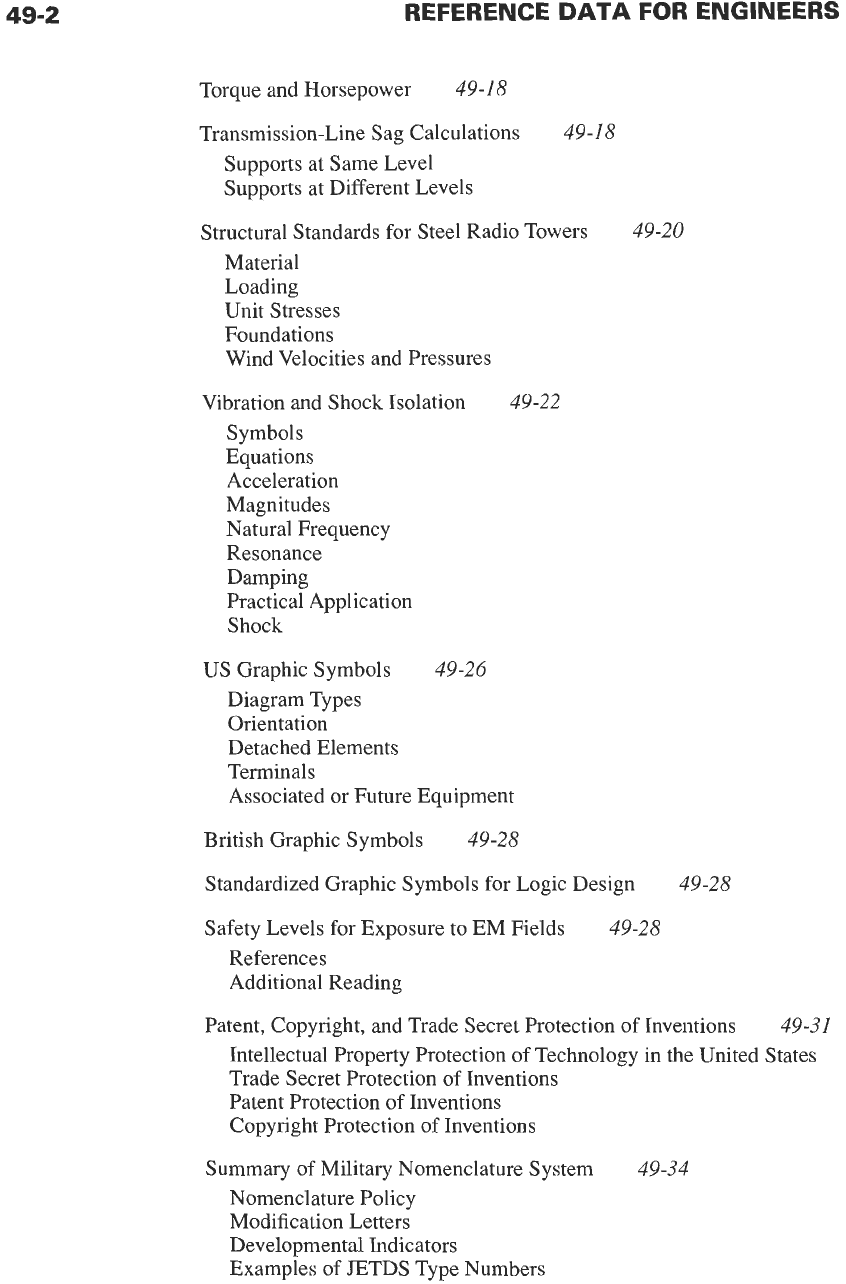
49-2
REFERENCE
DATA
FOR ENGINEERS
Torque and Horsepower
49-18
Transmission-Line Sag Calculations
49-18
Supports at Same Level
Supports
at Different Levels
Structural Standards for Steel Radio Towers
49-20
Material
Loading
Unit Stresses
Foundations
Wind Velocities and Pressures
Vibration and Shock Isolation
49-22
Symbols
Equations
Acceleration
Magnitudes
Natural Frequency
Resonance
Damping
Practical Application
Shock
US Graphic Symbols
49-26
Diagram Types
Orientation
Detached Elements
Terminals
Associated
or
Future Equipment
British Graphic Symbols
49-28
Standardized Graphic Symbols for Logic Design
49-28
Safety Levels for Exposure to EM Fields
49-28
References
Additional Reading
Patent, Copyright, and Trade Secret Protection of Inventions
49-31
Intellectual Property Protection of Technology in the United States
Trade Secret Protection
of
Inventions
Patent Protection
of
Inventions
Copyright Protection
of
Inventions
Summary
of
Military Nomenclature System
49-34
Nomenclature Policy
Modification Letters
Developmental Indicators
Examples
of
ETDS Type Numbers
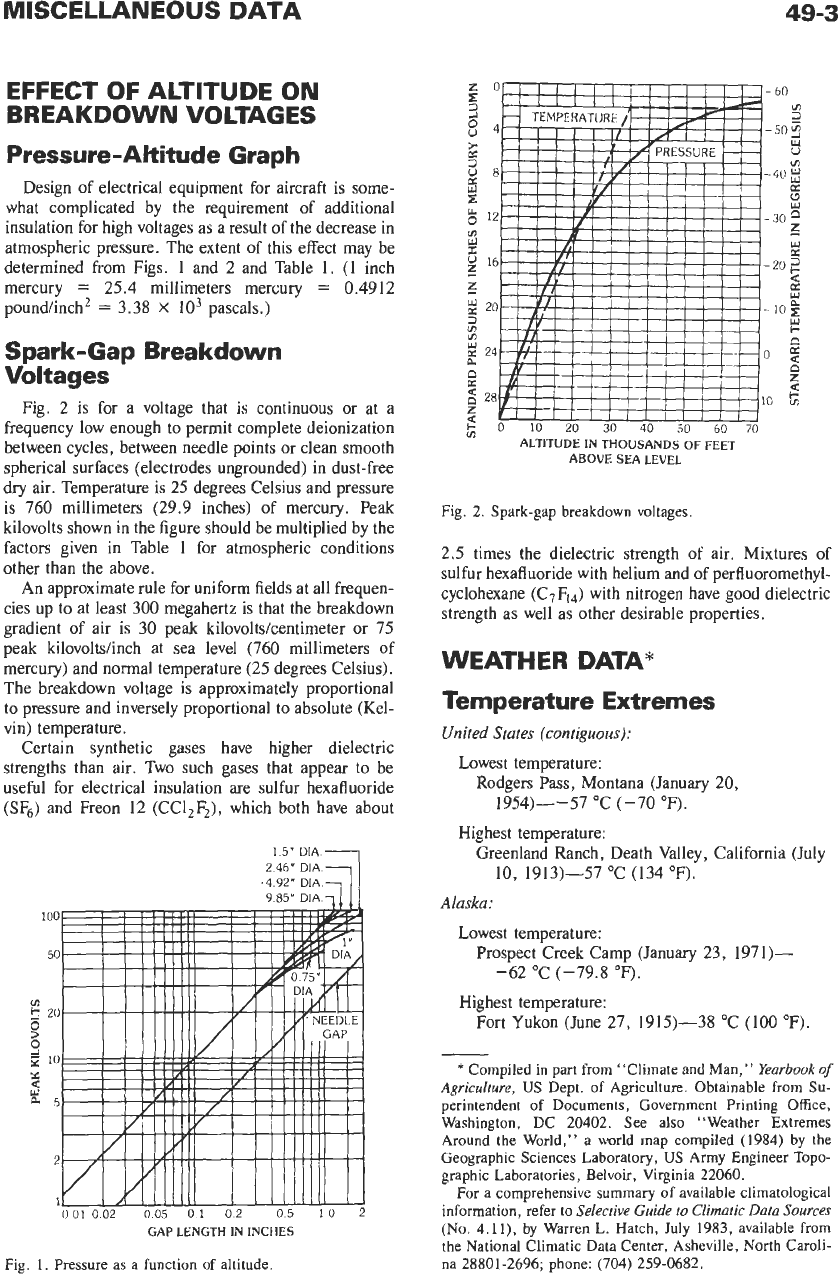
MISCELLANEOUS DATA
49-3
EFFECT OF ALTITUDE ON
BREAKDOWN VOLTAGES
Pressure-Altitude Graph
Design of electrical equipment for aircraft is some-
what complicated by the requirement of additional
insulation for high voltages as a result of the decrease in
atmospheric pressure. The extent of this effect may be
determined from Figs.
1
and
2
and Table
1.
(1
inch
mercury
=
25.4
millimeters mercury
=
0.4912
pound/inch2
=
3.38
X
IO3
pascals.)
Spark-Gap Breakdown
Voltages
Fig.
2
is for
a
voltage that is continuous or at a
frequency low enough
to
permit complete deionization
between cycles, between needle points or clean smooth
spherical surfaces (electrodes ungrounded) in dust-free
dry air. Temperature is
25
degrees Celsius and pressure
is
760
millimeters
(29.9
inches) of mercury. Peak
kilovolts shown in the figure should be multiplied by the
factors given in Table
1
for atmospheric conditions
other than the above.
An approximate rule for uniform fields at all frequen-
cies up to at least
300
megahertz is that the breakdown
gradient of air is
30
peak kilovoltskentimeter or
75
peak kilovolts/inch at sea level
(760
millimeters of
mercury) and
normal
temperature
(25
degrees Celsius).
The breakdown voltage is approximately proportional
to pressure and inversely proportional to absolute (Kel-
vin) temperature.
Certain synthetic gases have higher dielectric
strengths than air. Two such gases that appear to be
useful for electrical insulation are sulfur hexafluoride
(SF,) and Freon
12
(CCI,F;),
which both have about
100
50
v)
t;
20
9
4
2
10
3
L5
x
2
1
GAP LENGTH IN INCHES
Fig 1. Pressure as a function
of
altitude.
-
60
v)
5
2
3
8
-50
y
W
0
r
v)
Ez
3
-40
2
K
0
:
W
-30
z
s
5
K
-20
c>
z
<
z
W
0%
n
B
0
z
Ez
d
ob
n
0)
V
W
K
-
10
9
W
Ez
ln
c
C
0)
Q
z
2
0
10
20
30
40
50
60 70
ln
ALTITUDE IN THOUSANDS
OF
FEET
ABOVE SEA LEVEL
Fig. 2. Spark-gap breakdown voltages.
2.5
times the dielectric strength of air. Mixtures of
sulfur hexafluoride with helium and of perfluoromethyl-
cyclohexane
(C,
F14) with nitrogen have good dielectric
strength as well as other desirable properties.
WEATHER DATA*
Temperature Extremes
United States (contiguous):
Lowest temperature:
Rodgers Pass, Montana (January
20,
1954)--57
"C
(-70
"F).
Highest temperature:
Greenland Ranch, Death Valley, California (July
10,
1913)-57
"C
(134
OF).
Alaska:
Lowest temperature:
Prospect Creek Camp (January
23, 1971)-
-62
"C
(-79.8
OF).
Highest temperature:
Fort Yukon (June
27, 1915)-38
"C
(100
"F).
*
Compiled in part from "Climate and Man,"
Yearbook
of
Agriculture,
US
Dept. of Agriculture. Obtainable from
Su-
perintendent of Documents, Government Printing Office,
Washington, DC 20402.
See
also "Weather Extremes
Around the World," a world map compiled (1984) by the
Geographic Sciences Laboratory,
US
Army
Engineer
Topo-
graphic Laboratories, Belvoir, Virginia 22060.
For a comprehensive summary of available climatological
information, refer
to
Selective Guide
to
Climatic Data Sources
(No.
4.11), by Warren L. Hatch, July 1983, available from
the
National Climatic Data Center, Asheville, North Caroli-
na 28801-2696; phone:
(704)
259-0682.
